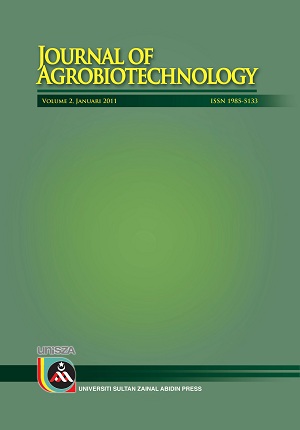Molecular Phylogenetics of Cypripedium L. (Cypripedioideae: Orchidaceae) Based on Plastid and Nuclear DNA Sequences
Abstract
The genus Cypripedium L. (Cypripedioideae: Orchidaceae) was in a state of taxonomic chaos for almost a century after the name was first established by Linnaeus. The beauty and scarcity of the plants has encouraged many taxonomists and botanists to investigate the relationships within Cypripedium. However, the studies often conflicted with each other and contributed towards difficulty in identification. In this study, a molecular phylogenetic analysis has been conducted on the two plastid DNA (rbcL and matK) and the nuclear DNA (ITS) in order to test the monophyly and intrageneric relationships in Cypripedium. The plastid data was combined with the nuclear ITS to further resolve the relationships among 38 investigated taxa of Cypripedium. Parsimony and Bayesian analyses indicated that the genus is monophyletic and C. irapeanum is sister to the rest of Cypripedium taxa. The phylogenetic results presented provide reliable information of intrageneric relationships in Cypripedium to be applied for future conservation studies. The present study confirmed the distinctiveness of all Endangered (C. farreri, C. fasciolatum, C. formosanum, C. franchetii, C. lichiangense and C. margaritaceum) and Critically Endangered (C. fargesii, C. henryi, C. smithii, C. wumegense and C. yunnanense) species listed in the International Union for Conservation of Nature, IUCN Red List of Threatened Species Database, thus supporting their worthiness for protection and conservation attention.
Keywords: Conservation, Cypripedium, ITS, matK, molecular phylogenetic, rbcL
Taksonomi genus Cypripedium L. (Cypripedioideae: Orchidaceae) telah berada dalam keadaan tidak stabil untuk hampir seabad lamanya selepas nama genus ini ditubuhkan oleh Linnaeus. Keindahan dan kepupusan tumbuhan ini telah mempergiatkan ramai pakar taksonomi dan ahli-ahli botani membuat penyiasatan terhadap hubungan-hubungan dalam Cypripedium. Walau bagaimana pun, kajian-kajian tersebut sering bercanggah di antara satu sama lain yang menyumbang ke arah kesukaran dalam pengenalpastian. Dalam kajian ini, suatu analisis filogenetik molekul telah dilaksanakan ke atas dua jenis plastid DNA (rbcL dan matK) dan satu DNA nukleus (ITS) bertujuan menguji monofili dan hubungan-hubungan intragenus dalam Cypripedium. Data plastid telah digabungkan dengan nuklear ITS untuk seterusnya menyelesaikan hubungan-hubungan antara 38 taksa Cypripedium. Analisis Parsimoni dan Bayesian menunjukkan Cypripedium adalah monofiletik dan C. irapeanum adalah kakak bagi keseluruhan taksa Cypripedium yang diuji. Hasil filogenetik menyediakan maklumat jelas hubungan-hubungan intragenus dalam Cypripedium untuk diaplikasikan dalam subjek pemuliharaan pada masa akan datang. Kajian mengesahkan sifat tersendiri semua spesis Terancam (C. farreri, C. fasciolatum, C. formosanum, C. franchetii, C. lichiangense dan C. margaritaceum) dan Sangat Terancam (C. fargesii, C. henryi, C. smithii, C. wumegense dan C. yunnanense) adalah tersenarai dalam ‘International Union for Conservation of Nature, IUCN Red List of Threatened Species Database’, seterusnya menyokong keperluan perlindungan dan perhatian terhadap pemuliharaan bagi spesis-spesis tersebut.
Kata kunci: Pemuliharaan, Cypripedium, ITS, matK, filogenetik molekul, rbcL


